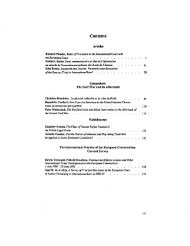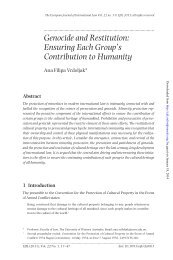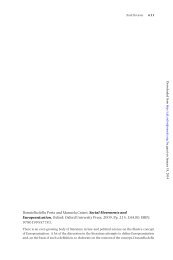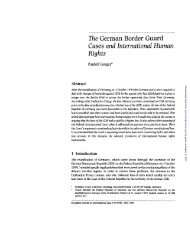Intangible Cultural Heritage - European Journal of International Law
Intangible Cultural Heritage - European Journal of International Law
Intangible Cultural Heritage - European Journal of International Law
You also want an ePaper? Increase the reach of your titles
YUMPU automatically turns print PDFs into web optimized ePapers that Google loves.
<strong>Intangible</strong> <strong>Cultural</strong> <strong>Heritage</strong>: The Living Culture <strong>of</strong> Peoples 105<br />
immaterial heritage was already perceived within UNESCO. This idea is also expressed<br />
in paragraph A, which defines folklore (considered tantamount to ‘traditional and<br />
popular culture’) as<br />
the totality <strong>of</strong> tradition-based creations <strong>of</strong> a cultural community, expressed by a group or individuals<br />
and recognized as reflecting the expectations <strong>of</strong> a community in so far as they reflect its cultural<br />
and social identity; its standards and values are transmitted orally, by imitation or by other<br />
means. Its forms are, among others, language, literature, music, dance, games, mythology,<br />
rituals, customs, handicrafts, architecture and other arts [emphasis added].<br />
In any event, the most innovative principle included in the RSTCF is incorporated<br />
in paragraph B, which proclaims that ‘[f]olklore, as a form <strong>of</strong> cultural expression, must<br />
be safeguarded by and for the group (familial, occupational, national, regional, religious,<br />
ethnic, etc.) whose identity it expresses’ (emphasis added). The RSTCF then establishes<br />
a set <strong>of</strong> principles providing guidelines for the identification, conservation, preservation,<br />
dissemination, and legal protection <strong>of</strong> folklore, as well as for promoting international<br />
cooperation.<br />
During the 1990s a number <strong>of</strong> initiatives for the safeguarding <strong>of</strong> ICH were undertaken<br />
in the context <strong>of</strong> UNESCO. 16 Among such initiatives the launch by UNESCO, in<br />
1994, <strong>of</strong> the Living Human Treasures programme is to be highlighted. 17 It was aimed<br />
at encouraging member states to grant <strong>of</strong>ficial recognition to exceptionally talented<br />
tradition bearers and craftspeople – who possess to a very high degree the knowledge<br />
and skills required for performing or creating specific elements <strong>of</strong> the ICH – as well<br />
as to encourage the transmission <strong>of</strong> their knowledge, knowhow, and skills to the<br />
younger generations.<br />
In 1996, the Report <strong>of</strong> the World Commission on Culture and Development emphasized<br />
that<br />
[d]evelopment presents new challenges for heritage conservation. Not only is there a huge gap<br />
between means and ends but our definitions are still too narrow. They are biased towards the<br />
elite, the monumental, the literate and the ceremonial. There is a need to reassess such conceptions<br />
as well as to develop better methods <strong>of</strong> identifying and interpreting our heritage. It is<br />
essential to understand the values and aspirations that drove its makers, without which an<br />
object is torn from its context and cannot be given its proper meaning. The tangible can only<br />
be interpreted through the intangible. 18<br />
A year later, the UNESCO General Conference adopted a resolution in which it decided<br />
‘to highlight the importance <strong>of</strong> the ICH for peoples and nations by proclaiming spaces<br />
or forms <strong>of</strong> cultural expression part <strong>of</strong> the “oral heritage <strong>of</strong> humanity”’. 19 This led the<br />
Downloaded from http://ejil.oxfordjournals.org/ by guest on January 18, 2014<br />
16<br />
For a more comprehensive assessment <strong>of</strong> such initiatives see Francioni, ‘The Protection <strong>of</strong> <strong>Intangible</strong> <strong>Cultural</strong><br />
<strong>Heritage</strong>: A New Challenge for UNESCO and <strong>International</strong> <strong>Law</strong>’, in Various Authors, Symposium:<br />
The Transmission and Present State <strong>of</strong> <strong>Cultural</strong> <strong>Heritage</strong> (2002), at 68, 69 ff.<br />
17<br />
See www.unesco.org/culture/ich/index.php?pg=00061&lg=EN (last accessed 6 Oct. 2010).<br />
18<br />
See J. Pérez de Cuéllar et al., Our Creative Diversity (1996), available at: http://unesdoc.unesco.org/<br />
images/0010/001055/105586e.pdf (last accessed 6 Oct. 2010), at 31.<br />
19<br />
See ‘The oral heritage <strong>of</strong> humanity’, Res. No. 23 <strong>of</strong> 12 Nov. 1997.








